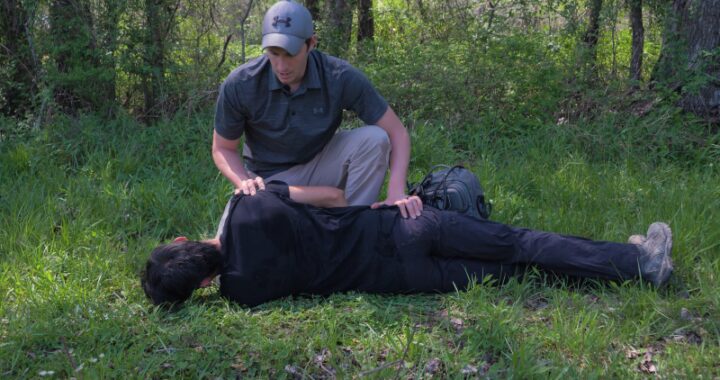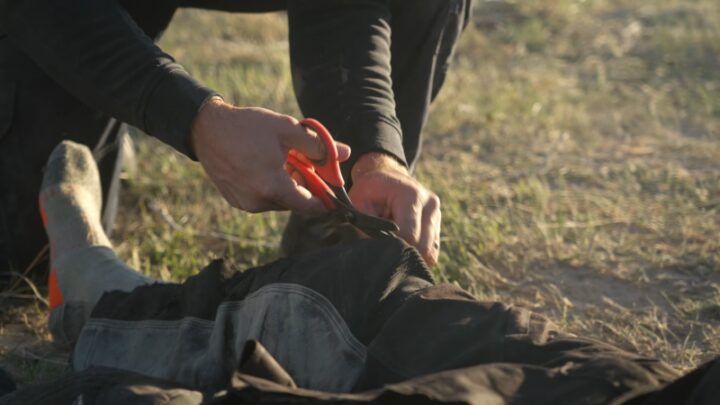Finding yourself injured during a hunting trip can be a frightening experience. Whether it’s a deep cut, a twisted ankle, or something more severe, it’s crucial to respond quickly and appropriately. Staying calm and knowing exactly what to do can prevent the situation from becoming more serious.
Let’s take a direct look at some steps you can take if you get injured while hunting.
Key Points
Assessing the Injury

When you’re injured, the first thing you must do is evaluate the situation:
- Take a moment to assess the extent of your injury. If it’s something minor, like a small cut or scrape, you might be able to treat it yourself.
- For more severe injuries, such as broken bones or deep wounds, immediate action is needed.
- While it’s tempting to rush, always pause and consider the best course of action.
- In the case of a gunshot wound, for instance, quick and efficient response is necessary.
- Carrying a workbag IFAK (Individual First Aid Kit) is essential for dealing with trauma like gunshot wounds or severe bleeding.
- Make sure the kit is compact and easily accessible, stored in your workbag, backpack, or even on your belt. When choosing a workbag IFAK, it’s important to find one that is both affordable and dependable, like those available from YEYETAC.
Stop the Bleeding
In the case of a deep cut or gunshot wound the main thing to do is stop the bleeding.
- For severe wounds, applying direct pressure is essential.
- Use a clean cloth or a medical dressing, and keep firm pressure on the wound to help slow down blood loss.
- Tourniquets can be life-saving when used properly. If you have one, it’s important to know exactly how and when to apply it. For instance, if the bleeding is uncontrollable and involves a limb, a tourniquet may be your only option.
- In some cases, a chest seal may be required, especially for gunshot wounds to the torso. A reliable chest seal can prevent air from entering the chest cavity, reducing the risk of a collapsed lung.
Immobilizing Fractures and Sprains
Accidents often lead to broken bones or severe sprains. When this happens, movement can worsen the injury.
- If you suspect a fracture or sprain, it’s essential to immobilize the affected area.
- Use a splint or any rigid object you have on hand, such as a stick or even a rifle, to prevent unnecessary movement.
- Secure the limb with strips of cloth or bandages to hold the splint in place. This will help reduce pain and prevent further damage while you prepare to get help.
Treating Minor Injuries
Not all injuries are severe. For minor cuts, scrapes, or blisters, it’s still important to clean the wound immediately to prevent infection.
- Use clean water or an antiseptic wipe from your first aid kit to clean the area.
- Apply a bandage or dressing to keep it clean and dry.
Blisters are another common issue, especially if you’re walking long distances. If a blister forms:
- Cover it with a moleskin pad or bandage to reduce friction.
- Don’t pop blisters unless absolutely necessary, as this increases the risk of infection!
Preventing Hypothermia and Shock
View this post on Instagram
If you’ve been injured in cold or wet conditions, hypothermia is a real danger. After treating the injury, focus on staying warm and dry. Wrap yourself in an emergency blanket, or use any available clothing to retain body heat.
Shock is also a concern after a major injury. Signs include:
- Pale skin
- Rapid breathing
- Weak pulse
Keep the person flat, elevate their legs, and keep them warm while waiting for emergency services.
Call for Help
When you’re injured and it’s clear that you can’t continue, the next step is to call for help. Whether it’s through a cell phone, radio, or personal locator beacon, reaching out for assistance is crucial when the injury is beyond basic first aid. Be sure to have your location ready to communicate effectively with rescue teams.
Additional Recommendations

- Always carry a compact first aid kit, such as a workbag IFAK, for emergencies.
- Get familiar with basic trauma care techniques before going on any trip.
- Take a course, like TCCC (Tactical Combat Casualty Care), to learn more advanced life-saving techniques.
- Equip yourself with reliable tools, like a tourniquet, chest seal, and splints.
- Regularly review your first aid supplies to ensure everything is intact and ready for use.
FAQ
In Conclusion
Injuries while hunting are unpredictable, but being prepared can significantly improve outcomes. Immediate response and knowing the right steps to take, from stopping bleeding to immobilizing fractures, can prevent a bad situation from getting worse.
Carrying essential tools, like a reliable first aid kit, ensures you have what you need to act quickly and efficiently. Equipping yourself with knowledge before heading out is just as important as the equipment you bring.
Ultimately, staying calm and assessing the situation can save your life or the life of a hunting partner. Every outdoor enthusiast should prioritize learning first aid skills, knowing how to use a tourniquet, chest seal, and other critical tools. Regularly review and update your supplies to ensure you’re always ready for an emergency.
My name is Natasa Pantelic, and I’m a content editor at geardisciple.com. While my professional background lies in business administration and makeup artistry, my true passions extend beyond the confines of the office. I find joy in maintaining my physical and mental well-being through strength training, cardio, and a balanced diet. Additionally, my love for music, socializing, and seeking out new adventures keeps life exciting. But perhaps above all, I have a deep appreciation for the great outdoors and revel in various outdoor activities whenever I can.